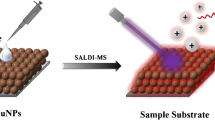Abstract
Osteoporosis (OP) constitutes a notable disorder within bone metabolism, characterized by the creation or desorption of porous bone. Osteocalcin (OC), a marker expressed by osteoblasts at various developmental stages, serves as a pivotal biomarker for diagnosing and monitoring osteoporosis. Current methodologies for quantifying OC, such as enzyme-linked immunosorbent assay (ELISA) and analogous antibody-based techniques, suffer from drawbacks including suboptimal thermostability, diminished sensitivity, and elevated manufacturing costs. In this study, a biosensor was engineered for the precise determination of OC, by using the osteocalcin-specific biorecognition receptor Gpr158 for the first time in the literature. A gold nanoparticle-modified gold screen-printed electrode was used as a working electrode, and electrochemical impedance spectroscopy (EIS) was employed as the primary measurement technique as a label-free method. To enhance system sensitivity, the working electrode was modified with fullerene, a carbon-based spherical nanomaterial. Subsequently, the electrode was immersed in sulfuric acid, activating the carbonyl structures on the fullerene, and through EDC/NHS the biorecognition receptor was immobilized with an amide bond. The efficacy of each modification step was evaluated using EIS and scanning electron microscopy (SEM). EIS was also utilized as an indicator method to analyze OC, revealing a linear determination range spanning from 0.5 to 100 ng/mL. The limits of detection (LOD) and quantification (LOQ) were calculated to be 0.51 ng/mL and 1.53 ng/mL, respectively. The biosensor, characterized by exceptional reproducibility, consistently yielded accurate results in the measurement of osteocalcin. This innovative approach holds promise as a robust and efficient means for diagnosing and monitoring osteoporosis, showcasing its potential as a valuable tool in clinical applications.







Similar content being viewed by others
References
Barco CMR, Arija SM, Pérez MR (2012) Biochemical markers in osteoporosis: usefulness in clinical practice. Reumatol Clín 8(3):149–152. https://doi.org/10.1016/j.reumae.2011.05.004
Bhadricha H, Khatkhatay MI, Desai M (2019) Development of an in house ELISA for human intact osteocalcin and its utility in diagnosis and management of osteoporosis. Clin Chim Acta 489:117–123. https://doi.org/10.1016/j.cca.2018.12.007
Choi JS, Park I, Lee SJ, Ju HJ, Lee H, Kim J (2019) Serum procollagen type I N-terminal propeptide and osteocalcin levels in korean children and adolescents. Yonsei Med J 60(12):1174. https://doi.org/10.3349/ymj.2019.60.12.1174
El Demellawy D, Davila J, Shaw A, Nasr Y (2018) Brief review on metabolic bone disease. Academic Forensic Pathology 8(3):611–640. https://doi.org/10.1177/1925362118797737
Garnero P, Cremers S (2019) Bone turnover markers. Principles of bone biology, 4th edn. Elsevier, London, pp 1801–1832
Hajj M, De Vita T, Renassia C, Bologna JC, Brabet I, Cazade M et al (2019) Nonclassical ligand-independent regulation of Go protein by an orphan class C G-protein–coupled receptor. Mol Pharmacol 96(2):233–246. https://doi.org/10.1124/mol.118.113019
Hauschka PV, Carr SA (1982) Calcium-dependent alpha-helical structure in osteocalcin. Biochemistry 21(10):2538–2547. https://doi.org/10.1021/bi00539a038
Inal Kabala S, Yagar H, Ozcan HM (2019) A new biosensor for osteoporosis detection. Prep Biochem Biotechnol 49(5):511–520. https://doi.org/10.1080/10826068.2019.1587628
Khashayar P, Amoabediny G, Hosseini M, Verplancke R, Razi F, Vanfleteren J et al (2017) An electrochemical biosensor based on AuNP-modified gold electrodes for selective determination of serum levels of osteocalcin. IEEE Sens J 17(11):3367–3374. https://doi.org/10.1109/JSEN.2017.2684903
Kim HY, Sato S, Takenaka S, Lee MH (2018) Membrane-based microwave-mediated electrochemical immunoassay for the in vitro, highly sensitive detection of osteoporosis-related biomarkers. Sensors 18(9):2933. https://doi.org/10.3390/s18092933
Li J, Zhang H, Yang C, Li Y, Dai Z (2016) An overview of osteocalcin progress. J Bone Miner Metab 34:367–379. https://doi.org/10.1007/s00774-015-0734-7
Liu YZ, Zhou Y, Zhang L, Li J, Tian Q, Zhang JG, Deng HW (2015) Attenuated monocyte apoptosis, a new mechanism for osteoporosis suggested by a transcriptome-wide expression study of monocytes. PLoS ONE 10(2):e0116792. https://doi.org/10.1371/journal.pone.0116792
Magnusson P, Häger A, Larsson L (1995) Serum osteocalcin and bone and liver alkaline phosphatase isoforms in healthy children and adolescents. Pediatr Res 38(6):955–961. https://doi.org/10.1203/00006450-199512000-00021
Malcolm AJ (2002) Metabolic bone disease. Curr Diagnost Pathol 8(1):19–25. https://doi.org/10.1054/cdip.2001.0091
Morgan EF, Barnes GL, Einhorn TA (2013) The bone organ system: form and function. Osteoporosis, 4th edn. Elsevier, London, pp 3–20
Seibel MJ (2005) Biochemical markers of bone turnover part I: biochemistry and variability. Clin Biochem Rev/aust Assoc Clin Biochem 26(4):97
Srivastava AK, Bhattacharyya S, Castillo G, Wergedal J, Mohan S, Baylink DJ (2000) Development and application of a serum C-telopeptide and osteocalcin assay to measure bone turnover in an ovariectomized rat model. Calcif Tissue Int 66:435–442. https://doi.org/10.1007/s002230010088
Uygun ZO, Yeniay L, Gi̇rgi̇n Sağın F, (2021) CRISPR-dCas9 powered impedimetric biosensor for label-free detection of circulating tumor DNAs. Anal Chim Acta 1121:35–41. https://doi.org/10.1016/j.aca.2020.04.009
Yamauch M, Yamaguchi T, Nawata K, Takaoka S, Sugimoto T (2010) Relationships between undercarboxylated osteocalcin and vitamin K intakes, bone turnover, and bone mineral density in healthy women. Clin Nutr 29(6):761–765. https://doi.org/10.1016/j.clnu.2010.02.010
Zoch ML, Clemens TL, Riddle RC (2016) New insights into the biology of osteocalcin. Bone 82:42–49. https://doi.org/10.1016/j.bone.2015.05.046
Acknowledgements
The author wants to thank the Center for Fabrication and Applications of Electronic Materials at Dokuz Eylul University, where SEM analyses were performed.
Author information
Authors and Affiliations
Corresponding author
Additional information
Publisher's Note
Springer Nature remains neutral with regard to jurisdictional claims in published maps and institutional affiliations.
Rights and permissions
Springer Nature or its licensor (e.g. a society or other partner) holds exclusive rights to this article under a publishing agreement with the author(s) or other rightsholder(s); author self-archiving of the accepted manuscript version of this article is solely governed by the terms of such publishing agreement and applicable law.
About this article
Cite this article
Ertuğrul Uygun, H.D. Use of osteocalcin-specific Gpr158 protein in biosensor technology for osteocalcin detection. Chem. Pap. (2024). https://doi.org/10.1007/s11696-024-03500-8
Received:
Accepted:
Published:
DOI: https://doi.org/10.1007/s11696-024-03500-8




